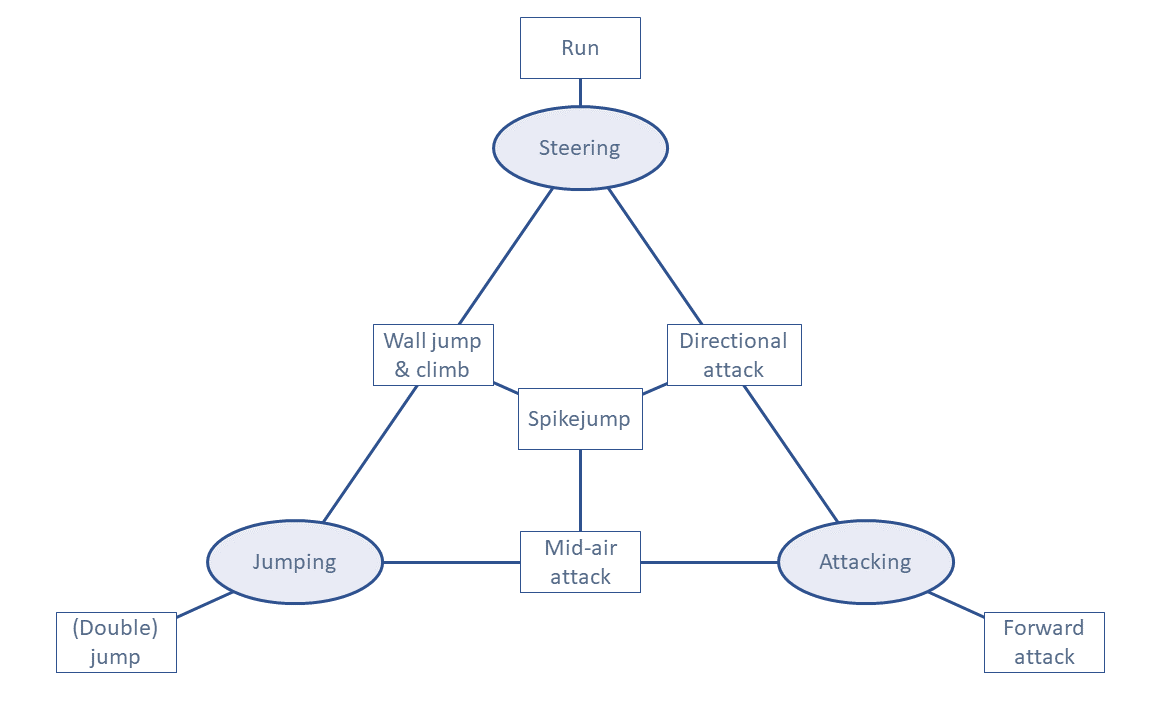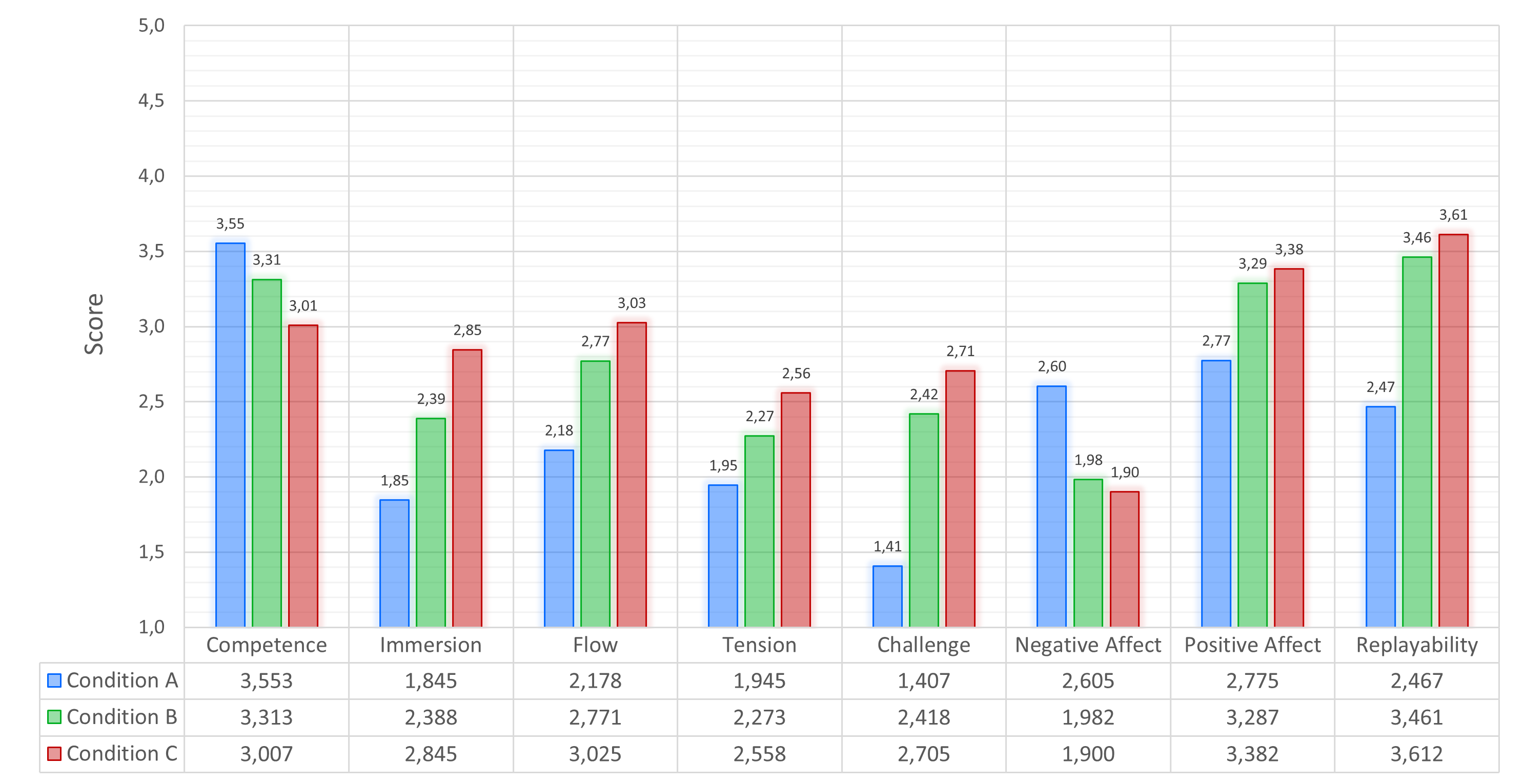Disclaimer
Before I start, let me just say that this is a huge project, and that this article does not truly do it justice. A lot of important stuff, such as the step-by-step explanation of the design strategy, GACE mapping, the inner workings of the character controller and level generation algorithm, the process of finding the right questionnaire, the experiment method, etc. is skipped for the sake of being concise and to the point. In order to fully understand the design strategy and the case study game, I advise readers to have a look at the report.
Background
Late 2021, my master Interaction Technology was coming to an end, and it became time to choose a thesis project. At this point, the "try a bit of everything" philosophy that was prominent during my bachelors and early masters had almost fully subsided, as I had discovered my love for game development and was trying to solely focus on that. As such, I wanted to develop a video game as my final project. However, a master thesis has to meet certain requirements. For starters, it requires that I performed an experiment of some kind. Additionally, it was important that my project offers some scientific value, such as new insights or methods, which is something that simply developing a product does not do. Lastly, at my university, the only focus regarding video games was on serious games. Serious games are games that aim to serve a serious purpose, such as education or promoting exercise, aside from pure entertainment. I had previously worked on serious games and even followed a minor ‘serious gaming’, but I always found them to be lacking in terms of enjoyment (See chapter 1 of the report). This was one of the main things I planned to focus on during my thesis; game design. Thinking about why developers do certain things, rather than how they do it. In the end, it turned out that being limited to serious games was actually an advantage, since these are the type of games that, in my opinion, could improve the most in this regard.
Sneakily Purposeful Games
So, I was on a mission to create serious games that offer similar levels of enjoyment as regular games, but are still capable of serving their serious purposes. Although my initial goal was to develop a video game as a product, this did not meet the requirements of the university, so instead of doing this, I proposed a new design strategy for serious games. The fundamental principle behind this design strategy is that regular video games are perfectly capable of serving serious purposes (e.g. improved hand-eye coordination). This serious purpose is often times a side effect caused by having to repeat certain actions over and over in the game. However, this does show that video games can serve serious purposes without sacrificing their entertainment value. My design strategy aims to guide this side effect to align with the intended goal, whilst preventing the serious goal(s) from imposing major limitations upon the game that could come at the cost of the enjoyment. The final product should feel like a regular video game but could still be used to serve a serious purpose, hence the name of the design strategy; Sneakily Purposeful Games. The logic and rationale behind the design strategy is explained step-by-step in chapter 3 in the report.
Evaluating the design strategy
A short gameplay demo. This was recorded in Unity while the game was still being developed, but it does give a decent impression regarding the gameplay.
The game I made is an untitled 2D action platformer roguelite. It focusses on testing the player’s platforming abilities with a variety of hazards and challenges. It is a roguelite, since it employs both procedural level generation and permadeath, but with persistent upgrades across different playthroughs. The serious aspect comes in the form of physical exercises, which are used to control the game (e.g. squeeze a ball to jump). A major problem facing physical rehabilitation is that patients often lack interest in performing repetitive exercises or ensuring that they complete the program. By linking these exercises to a fun game, there is an increase in intrinsic motivation to perform them, which is the serious goal. The design strategy intentionally doesn’t go into great depth regarding these exercises (see chapter 3 of the report).
The game has a tile-based pixel art artstyle and takes place in a feudal Japanese-like setting with some fantasy elements. For replayability purposes, the primary focus of the game is on the core gameplay, which is centered around 3 core mechanics: Steering / running, jumping, and attacking. Each of these core mechanics could relate to a different kind of exercise, which makes the game suitable for different rehabilitation programs. The core mechanics can also be combined to create more complex moves. The levels can be generated such that they can be completed using only the surface level mechanics, or in a way that they specifically incentivize certain gameplay actions or more advanced movement and combat options. Chapters 5 and 6 of the report give a more in-depth description of the development process and the design choices I made.
Although the game only served as a means to evaluate the design strategy, I did spend a lot of time on it. Partially because creating a game from scratch is just a lot of work, but admittedly also partially because this was a part of the project that I enjoyed working on the most. And although the final product is definitely still lacking some polish, it is a surprisingly enjoyable game to play, and I caught myself playing it sometimes, even after I was done working for the day. The game is still available for download in the same state as it was distributed for the experiment. As a hobby project, I'm currently also working on an improved version of this same game, which may appear on this website later.
The experiment
In order to measure the experience that this case study game offered, I performed an experiment. Participants would play the game in a few different conditions that reflect different balances between seriousness and enjoyment (Condition A prioritizes the serious aspect, Condition C prioritizes enjoyment), and evaluated the gaming experience using the Game Experience Questionnaire (GEQ). Over a period of 2 weeks, 59 people participated in this experiment. The participants were very diverse in terms of how experienced of a gamer they were. There were people who barely ever play video games, or only really play a certain type of game, but also people with 3000+ hours on a single game, people with global rankings, speedrunners, and aspiring game developers. This helped me to approach the game from different angles and take multiple differing perspectives into account.
Conclusion
The experiment showed that the game offered a much more enjoyable experience when fun is considered to be a priority, but also that, using this strategy, this does not require significant concessions regarding the serious aspect. In addition to this, I also showed that, even when prioritizing seriousness over fun, there are certain tricks that developers can use to significantly reduce the negative impact this has on the enjoyment. Looking back, this has been a great project that has taught me a lot and was a great pleasure to work on. The final grade I received as an 8/10.

